With Google featuring Vietnamese historical and cultural symbols several times on its homepage, these have reached a global audience.
The Google Doodle is a special temporary presentation that commemorates holidays, events, achievements and people.
Vietnamese celebrations like Tet (Lunar New Year Festival), the Mid-autumn Festival, Teachers’ Day, Independence Day and cultural symbols of the country have showed up on the search engine’s home page.
Banh chung
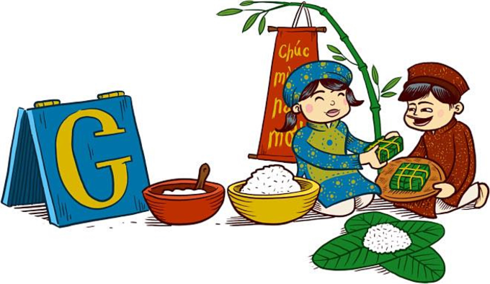
A screenshot from Google Doodle features a family gathering to wrap and cook banh chung on Lunar New Year’s Eve in 2013.
On Lunar New Year’s Eve in 2013, banh chung, the square-shaped sticky rice cake wrapped in large green leaves known as la dong (phrynium placentarium) with mung beans and pork, was featured on Google Doodle.
The image of a family gathering to wrap and cook banh chung is a familiar sight and indispensable part of Tet, the most important and biggest holiday in Vietnam.
Khue Van Cac
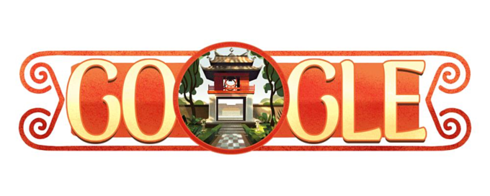
A screenshot from Google Doodle features the image of Khue Van Cac,the pavilion of the Constellation of Literature located inside the Temple of Literature in 2017.
In 2017, on the occasion of Viet Nam’s National Day that marks the declaration of independence on September 2, 1945 by Ho Chi Minh, the founder of the Vietnamese Communist Party, Google featured the image of Khue Van Cac, the pavilion of the Constellation of Literature located inside the Temple of Literature, Vietnam’s first national university, on its homepage.
The pavilion was built in 1805 under the reign of Nguyen Dynasty (1802-1945) on four stone stilts with two red windows on top and an elaborate roof. It was chosen as the official symbol of the 1,000-year-old capital city in 2012.
Traditional dress and national flower
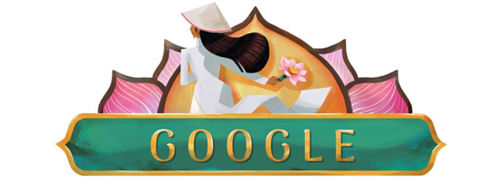
A screenshot from Google Doodle features the image of a woman in a white ao dai with a pink lotus in 2018.
The ao dai has long been a symbol of Vietnamese culture and considered as the country’s traditional dress. Last year, Google carried the image of a woman in a white ao dai with a pink lotus, Vietnam’s national flower, on its homepage.
The ao dai is a Vietnamese national garment worn by both sexes but now most commonly worn by women. In its current form, it is a tight-fitting silk tunic worn over loose trousers.
Hung Kings Temple Festival
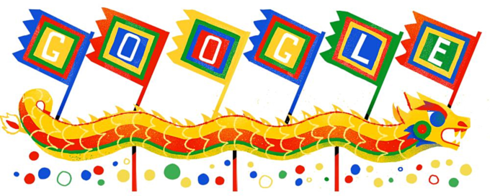
A screenshot from Google Doodle 2018 captures the image of lion dances,a ceremony to celebrate the Hung Kings Temple Festival.
In 2018, Google introduced the Hung Kings Temple Festival, an official celebration of Vietnamese people, as a special event on its homepage, with the image of a lion dance.
Vietnamese celebrate the commemoration day of the Hung Kings (2879-258 BCE), the nation's mythical founders, on the 10th of the third lunar month every year.
On the day, people from different parts of the country flock to the Hung Kings Temple on Nghia Linh Mountain in Phu Tho, a northern province neighboring Hanoi, to offer incense to the mythical founders of Viet Nam on their death anniversary.
Pagoda Bridge and floating lanterns
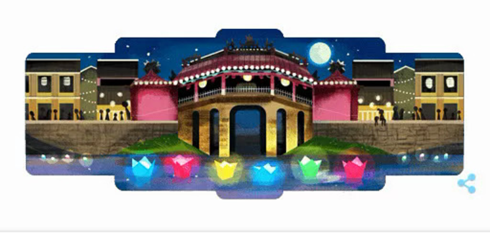
A screenshot from Google Doodle featuring Hoi An on its homepage, July 16, 2019.
In its latest depiction of Vietnamese symbols, the Google Doodle featured the ancient town of Hoi An last Tuesday, making it the first Vietnamese destination to be honored thus.
The doodle coincided with the traditional Lantern Festival, held on the 14th day of each lunar month.
An image of Hoi An in central Viet Nam with symbols of the Chua Cau (Pagoda Bridge) and colorful lanterns became Google’s logo for the day.
The Pagoda Bridge, a national relic that appears on VND20,000 ($0.86) bills, has been an iconic landmark of the 400-year-old town. It was built in the early 17th century by Japanese traders who once made up a large part of the town’s population.
Colorful floating lanterns are also a distinct feature of Hoi An where lights are switched off during the lantern festival and the only light comes from the lanterns being floated on the river.
















